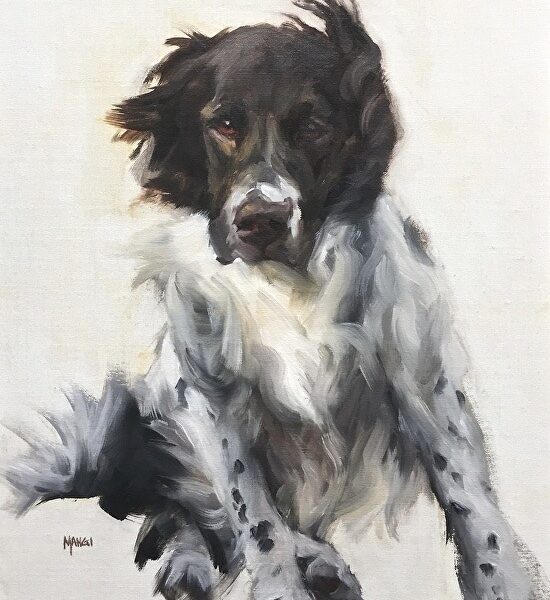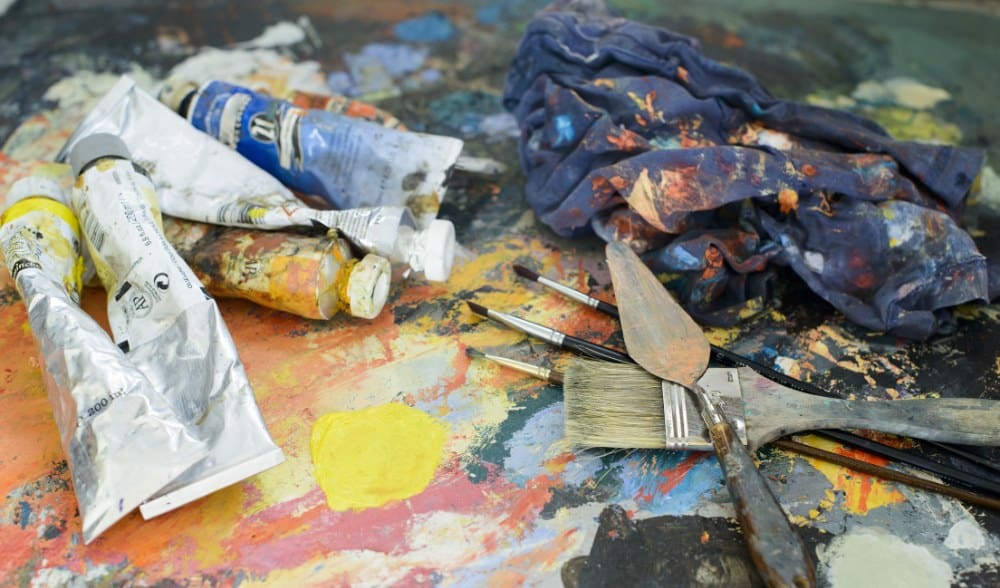How to Start Acrylic Painting Without Wanting to Snap Your Brushes in Half
This guide is BIG. (It’s meant to be.)
Acrylics are one of the most versatile, forgiving, and joyfully chaotic mediums you can use—perfect for beginners, dabblers, or anyone who’s taken a 3-year detour into hoarding paint supplies without actually making anything. No judgment. Been there. 🥲
Whether you’re just starting or you want to nerd out on acrylic paint with me, this post is a full-spectrum walk-through of everything you actually need to know to get going (without spiraling into overwhelm). Supplies, surfaces, techniques, color mixing, common mistakes—I’m holding your hand through the whole shebang.
Everything here is tested, tweaked, and filtered through the lens of “what actually works and doesn’t make me want to throw a paintbrush across the room.” You’re getting the good stuff: No filler, no pressure.
Let’s go, my little painting besties.
This post includes affiliate links. For more information, see my disclosure policy here.
What You Actually Need to Get Started With Acrylics
You do not need a full cart of supplies to start painting with acrylics. The internet will try to convince you otherwise, but it’s all LIES. 😆 Here’s what you actually need:
Bare Minimum Supplies

Acrylic Paint
Start with a primary color set or a warm/cool split. You need red, blue, yellow, white, and optionally black (or better yet, mix your own!).

Surface to Paint on
Paper, canvas panel, wood panel, or even cardboard. Whatever you have works – each surface will yield a different result.

Brushes
A couple of decent synthetic brushes in different shapes (flat and round) will take you far. (#6 or #8 size is a good place to start).

Water Container
For rinsing brushes. An old mug works.

Palette
Disposable paper palette, reusable plastic one, or just a plate. I use freezer paper.

Rag or Paper Towels
For dabbing, blotting, and cleaning up messes.
Done! You can paint now. 🥳
The “Level Up” Add-ons
Once you get rolling, these are the next things that’ll make your life easier or your art more fun:
What Surfaces Can You Use for Acrylic Painting?
One of the best things about acrylic paint is that it sticks to almost anything. But if you’re wondering where to begin, I’ve got you.
Easiest Surfaces for Beginners
Let’s keep it simple first.
Surfaces for More Control or More Texture
Once you know how you like to paint, you’ll find your ride-or-die surfaces.
Quick Tips for Any Surface
Let’s keep it simple first.
So… What Is Acrylic Paint, Anyway?
Acrylic paint is water-based, quick-drying, and wildly versatile. It’s made from pigment (color) suspended in an acrylic polymer binder—that’s the magic goo that helps it stick to just about any surface: canvas, wood, paper, you name it.
It dries fast (sometimes too fast), layers well, and can go from watercolor-sheer to thick and textured depending on how you use it. Add water to thin it, mediums to tweak it, or just dive in straight from the tube.
It’s beginner-friendly, doesn’t need solvents, and plays well with almost every other material in your art stash. Boom.
Basic Acrylic Painting Techniques (Do these right now. Don’t think; just do 🤖)
You don’t need to master all of these—but try a few, and watch your confidence pop off.

01
Flat Color
Just what it sounds like. Use a smooth brushstroke to lay down a single color in a clean, even layer. Super useful for backgrounds or blocking in shapes.
Try it: Mix your color, grab a soft brush, and see if you can cover an area without streaks.

02
Dry Brush
A favorite for texture lovers. Use a brush with very little paint and skip the water. It creates a scratchy, expressive mark—great for adding grit or distress.
Try it: Dip just the tip of your brush into paint, then lightly drag it across your surface.

03
Glazing
Thin layers of translucent paint stacked on top of each other = juicy color depth. You can use water or acrylic mediums for this.
Try it: Mix paint with glazing medium and brush it over a dry layer. Let each layer dry before adding the next.

04
Layering
Acrylics dry fast, which makes them killer for stacking layers. Paint something. Let it dry. Paint on top. Repeat.
Try it: Create a simple design with three layers. Watch how they interact.

05
Scraping
Palette knives, old gift cards, plastic spoons—whatever. Scraping paint adds energy and texture and feels fun AF.
Try it: Drop a blob of paint, then scrape it across the surface with a tool.

06
Sgraffito
Fancy word for scratching into wet paint to reveal what’s underneath. Use the end of a brush, a stick, a toothpick. It’s very satisfying.
Try it: Paint a layer, let it dry, add a second color, and scratch a design through it while still wet.

07
Splatter
Messy on purpose. Flicking watered-down paint onto your surface adds movement and spontaneity. Just cover anything nearby first unless you like permanently speckled walls.
Try it: Load a toothbrush or stiff brush with watery paint and flick it with your finger.
Beginner Practice Prompt: The “Technique Sampler”
Before you dive into your next real painting, take 20–30 minutes to make a sampler page using the techniques above. It’s like a warm-up sketch for your paint muscles.
Here’s what to do:
- Grab a sheet of watercolor paper, a wood panel, or whatever surface you’ve got prepped.
- Pick 3–5 of the techniques from the list.
- Use a limited color palette (2–3 colors + white) to keep it simple.
- Make little swatches or marks of each technique on the page—don’t worry about it looking good.
Why this helps:
You’ll loosen up, get familiar with your tools, and build a kind of visual vocabulary you can pull from later. Plus, it feels low-pressure—like doodling with paint.

Acrylic Color Mixing Basics: How Not to End Up with Mud
You don’t need a degree in color theory to mix colors well—but a few smart habits can save you a lot of frustration (and brown sludge).
1. Start with a limited palette
Fewer colors = fewer chances to make a color that is not of this world. You’d be amazed what you can mix from:
Play with what just those few can do. You’ll get to know your colors like old friends.
2. Clean your brush more often than you think you need to
Even a tiny bit of the wrong color on your brush can throw off a mix. If your greens keep turning to swamp, your brush is probably to blame.
3. Understand warm vs cool versions of each primary
This is where color mixing gets tricky, especially for beginners. The same “red” can lean more yellow (warm) or more blue (cool), and that subtle shift totally changes what happens when you mix it.
Here’s the most important rule to avoid mud:
To mix clean secondaries (like green, orange, purple), choose primary colors that don’t contain the third primary.
Wait—what?
Let’s break it down:
- To mix a clean purple, use a red and a blue that don’t have yellow in them (e.g. quinacridone magenta + ultramarine blue).
- To mix a clean green, use a yellow and a blue that don’t have red in them (e.g. hansa yellow + phthalo blue).
- To mix a clean orange, use a red and a yellow that don’t have blue in them (e.g. cadmium red light + cadmium yellow light).
Here’s what to do:
- Grab a sheet of watercolor paper, a wood panel, or whatever surface you’ve got prepped.
- Pick 3–5 of the techniques from the list.
- Use a limited color palette (2–3 colors + white) to keep it simple.
- Make little swatches or marks of each technique on the page—don’t worry about it looking good.
If your red is actually kind of orangey (has yellow in it), and your blue is greenish (has yellow too), you just invited yellow to the purple party—and yellow + purple = brown. Womp womp.
So:
- Warm + cool can actually be better than warm + warm in some cases.
- What matters most is the pigment’s bias—not just how it looks.
4. Use a palette knife to mix
It keeps your colors cleaner, and you’ll have more control over small adjustments.
5. Keep scrap paper nearby
Test your mixes before committing to the canvas. Colors look different once they’re dry—and on different surfaces.
Tip: Don’t just mix with white to lighten a color. Try yellow for a warmer shift, or use glazing medium to keep the saturation while lightening the value.
Bonus Color-Mixing Sheet
Still with me? Good. Let’s go just a little deeper into the magic (and the mistakes) of mixing colors. This cheat sheet covers the most common ways people end up with mud—and how to fix it.
How Not to Make Mud (Unless You Want To)
1. Warm vs Cool Primaries = THE KEY
This is where 99% of beginner mixing goes sideways. Every primary color (red, blue, yellow) comes in warm and cool versions. If you mix two warms, you’re bringing extra yellow into the mix—and yellow neutralizes purple. The result? Sad brown slop.
Here’s the cheat:
| Mix Type | Example Colors | Result |
| Warm + Warm | Cadmium Red + Ultramarine Blue | Muddy neutral (brown) |
| Cool + Cool | Alizarin Crimson + Phthalo Blue | Clean, rich purple |
| Warm + Cool | Cadmium Yellow + Phthalo Blue | Green, often weird (but interesting) |
2. Know Your Bias
Every pigment leans a certain way—even if it’s labeled “red.” Here’s a quick starter map:
| Color | Warm Version | Cool Version |
| Red | Cadmium Red | Alizarin Crimson |
| Yellow | Cadmium Yellow Deep | Lemon Yellow / Hansa YL |
| Blue | Ultramarine Blue | Phthalo Blue / Cerulean |
3. The Dirty Little Secret of White Paint
Titanium white can dull or “chalk out” your mixes—great for pastel tones, but if your colors feel lifeless, it might be too much white.
Try Zinc White or Mixing White if you want a gentler lift.
4. A.B.T. (Always Be Testing) (Yes, I am a nerd) (Y.I.A.A.N.)
Paint swatches! Label them! Try mixing two colors in three different ratios and see what happens. You’ll build a muscle for color that theory alone can’t give you.
Here, have a printable!
Want to keep track of your favorite color combos? Print this page and swatch your mixes on the left—then use the boxes on the right to jot down the paints you used, ratios, weird surprises, or “never again” warnings. P.S. I print on card stock, but some printers will print on watercolor paper.
Wrapping It Up: You’re Officially an Acrylic Paint Nerd Now
You’ve got enough here to paint for years. For reals. You don’t need to master everything—just pick a place to start.
Whether you’re standing in the art aisle groping all of the paint brushes, or you’re five paintings deep and ready to try gel mediums or wild mixed-media experiments, this post is your home base.
I’ll be adding more in-depth guides soon on:
- Acrylic mediums (and which ones are actually worth the money)
- Using acrylics in collage and mixed media
- Color mixing!!! (This will be juicy.)
If you want those posts (plus occasional printables and early access to new tutorials), hop on the email list.
And finally: Don’t overthink it! Pick up a brush and start. The fastest way to get good is to make a mess and see what happens.
Now go paint something weird.








